
An armoured fighting vehicle or armored fighting vehicle (AFV) is an armed combat vehicle protected by armour, generally combining operational mobility with offensive and defensive capabilities. AFVs can be wheeled or tracked. Examples of AFVs are tanks, armoured cars, assault guns, self-propelled artilleries, infantry fighting vehicles (IFV), and armoured personnel carriers (APC).

A siege is a military blockade of a city, or fortress, with the intent of conquering by attrition, or by well-prepared assault. Siege warfare is a form of constant, low-intensity conflict characterized by one party holding a strong, static, defensive position. Consequently, an opportunity for negotiation between combatants is common, as proximity and fluctuating advantage can encourage diplomacy.

A fortification is a military construction designed for the defense of territories in warfare, and is used to establish rule in a region during peacetime. The term is derived from Latin fortis ("strong") and facere.
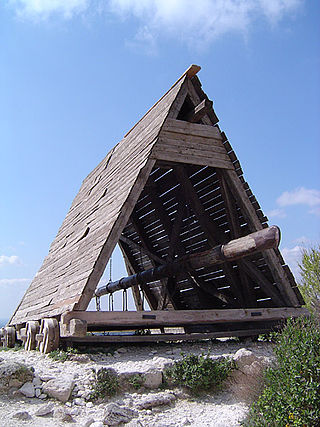
A siege engine is a device that is designed to break or circumvent heavy castle doors, thick city walls and other fortifications in siege warfare. Some are immobile, constructed in place to attack enemy fortifications from a distance, while others have wheels to enable advancing up to the enemy fortification. There are many distinct types, such as siege towers that allow foot soldiers to scale walls and attack the defenders, battering rams that damage walls or gates, and large ranged weapons that attack from a distance by launching projectiles. Some complex siege engines were combinations of these types.

The siege of Port Hudson was the final engagement in the Union campaign to recapture the Mississippi River in the American Civil War. While Union General Ulysses Grant was besieging Vicksburg upriver, General Nathaniel Banks was ordered to capture the lower Mississippi Confederate stronghold of Port Hudson, Louisiana, to go to Grant's aid. When his assault failed, Banks settled into a 48-day siege, the longest in US military history up to that point. A second attack also failed, and it was only after the fall of Vicksburg that the Confederate commander, General Franklin Gardner, surrendered the port. The Union gained control of the river and navigation from the Gulf of Mexico through the Deep South and to the river's upper reaches.
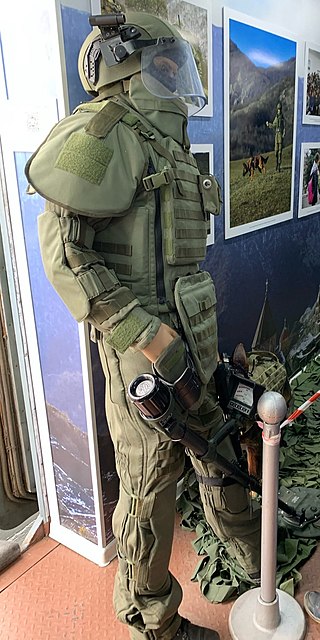
A sapper, also called a combat engineer, is a combatant or soldier who performs a variety of military engineering duties, such as breaching fortifications, demolitions, bridge-building, laying or clearing minefields, preparing field defenses, and road and airfield construction and repair.

A warship or combatant ship is a ship that is built and primarily intended for naval warfare. Usually they belong to the armed forces of a nation. As well as being armed, warships are designed to withstand damage and are typically faster and more maneuverable than merchant ships. Unlike a merchant ship, which carries cargo, a warship typically carries only weapons, ammunition and supplies for its crew. Warships usually belong to a navy, though they have also been operated by individuals, cooperatives and corporations.
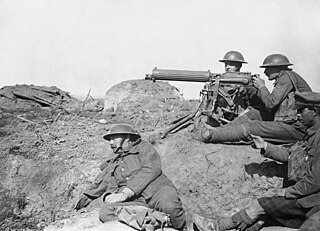
Technology during World War I (1914–1918) reflected a trend toward industrialism and the application of mass-production methods to weapons and to the technology of warfare in general. This trend began at least fifty years prior to World War I during the American Civil War of 1861–1865, and continued through many smaller conflicts in which soldiers and strategists tested new weapons.
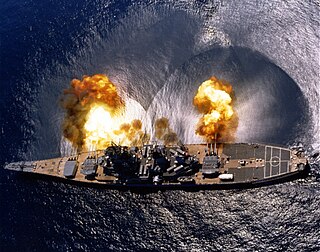
Naval gunfire support (NGFS), also known as naval surface fire support (NSFS), or shore bombardment, is the use of naval artillery to provide fire support for amphibious assault and other troops operating within their range. NGFS is one of several disciplines encompassed by the term naval fires. Modern naval gunfire support is one of the three main components of amphibious warfare assault operations support, along with aircraft and ship-launched land-attack missiles. Shipborne guns have been used against shore defences since medieval naval warfare.

The siege of Port Arthur was the longest and most violent land battle of the Russo-Japanese War.

Coastal artillery is the branch of the armed forces concerned with operating anti-ship artillery or fixed gun batteries in coastal fortifications.
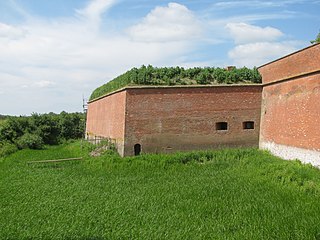
A sallyport is a secure, controlled entry way to an enclosure, e.g., a fortification or prison. The entrance is usually protected by some means, such as a fixed wall on the outside, parallel to the door, which must be circumvented to enter and prevents direct enemy fire from a distance. It may include two sets of doors that can be barred independently to further delay enemy penetration.

A bastion fort or trace italienne is a fortification in a style that evolved during the early modern period of gunpowder when the cannon came to dominate the battlefield. It was first seen in the mid-fifteenth century in Italy. Some types, especially when combined with ravelins and other outworks, resembled the related star fort of the same era.

Industrial warfare is a period in the history of warfare ranging roughly from the early 19th century and the start of the Industrial Revolution to the beginning of the Atomic Age, which saw the rise of nation-states, capable of creating and equipping large armies, navies, and air forces, through the process of industrialization.

The Battle of Königsberg, also known as the Königsberg offensive, was one of the last operations of the East Prussian offensive during World War II. In four days of urban warfare, Soviet forces of the 1st Baltic Front and the 3rd Belorussian Front captured the city of Königsberg, present day Kaliningrad, Russia. The siege started in late January 1945 when the Soviets initially surrounded the city. Heavy fighting took place for control of overland connection between Königsberg and the port of Pillau, however by March 1945 Königsberg was hundreds of kilometres behind the main front line in the eastern front. The battle ended when the German garrison surrendered to the Soviets on 9 April after a three-day assault made their position untenable.
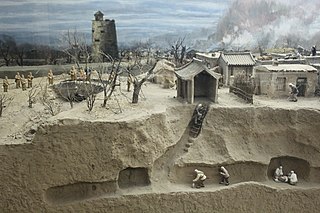
Tunnel warfare is using tunnels and other underground cavities in war. It often includes the construction of underground facilities in order to attack or defend, and the use of existing natural caves and artificial underground facilities for military purposes. Tunnels can be used to undermine fortifications and slip into enemy territory for a surprise attack, while it can strengthen a defense by creating the possibility of ambush, counterattack and the ability to transfer troops from one portion of the battleground to another unseen and protected. Also, tunnels can serve as shelter from enemy attack.
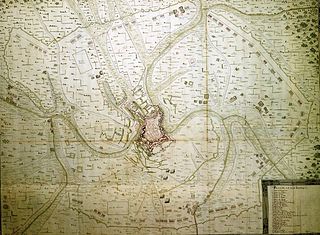
The siege of Luxembourg, in which Louis XIV of France laid siege to the Spanish-controlled Fortress of Luxembourg from 27 April to 7 June 1684, was the most significant confrontation of the War of the Reunions between France and Spain. The action caused alarm among France's neighbours and resulted in the formation of the League of Augsburg in 1686. In the ensuing war France was forced to give up the duchy, which was returned to the Habsburgs by the Treaty of Ryswick in 1697.

Sapping is a term used in siege operations to describe the digging of a covered trench to approach a besieged place without danger from the enemy's fire. The purpose of the sap is usually to advance a besieging army's position towards an attacked fortification. It is excavated by specialised military units, whose members are often called sappers.

The Battle of Fort Ében-Émael was a battle between Belgian and German forces that took place between 10 May and 11 May 1940, and was part of the Battle of Belgium and Fall Gelb, the German invasion of the Low Countries and France. An assault force of German paratroopers, Fallschirmjäger, was tasked with assaulting and capturing Fort Ében-Émael, a Belgian fortress whose strategic position and strong artillery emplacements dominated several important bridges over the Albert Canal. These carried roads which led into the Belgian heartland and were what the German forces intended to use to advance. As some of the German airborne forces assaulted the fortress and disabled the garrison and the artillery pieces inside it, others simultaneously captured three bridges over the canal. Having disabled the fortress, the airborne troops were then ordered to protect the bridges against Belgian counter-attacks until they linked up with ground forces from the German 18th Army.
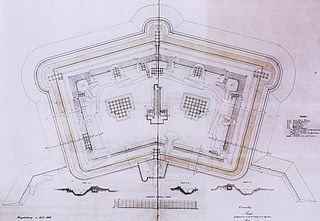
A polygonal fort is a type of fortification originating in France in the late 18th century and fully developed in Germany in the first half of the 19th century. Unlike earlier forts, polygonal forts had no bastions, which had proved to be vulnerable. As part of ring fortresses, polygonal forts were generally arranged in a ring around the place they were intended to protect, so that each fort could support its neighbours. The concept of the polygonal fort proved to be adaptable to improvements in the artillery which might be used against them, and they continued to be built and rebuilt well into the 20th century.



















